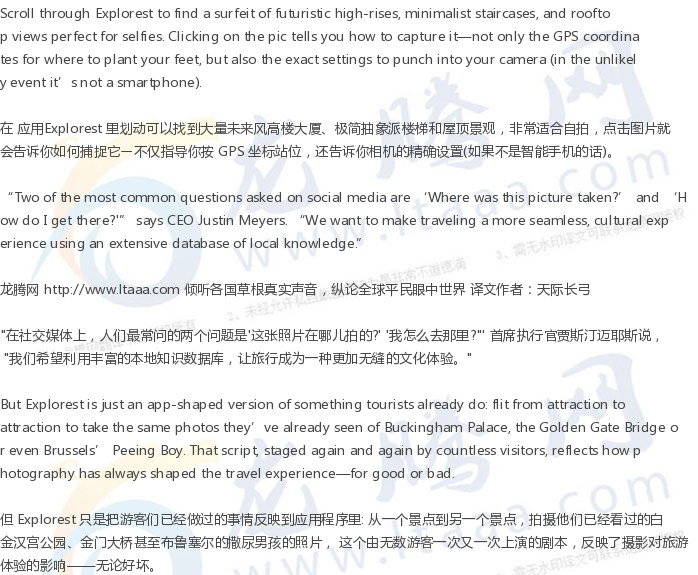为什么我们要去拍同样的旅行照片 [美国媒体]
占地426平方英里的香港拥有740万人口,对游客来说,香港可能过于拥挤。 但是现在有一个应用程序可以准确地告诉你应该看什么ー或者更准确地说,应该拍什么。
Why We All Take the Same Travel Photos
为什么我们要去拍同样的旅行照片
作者: LAURA MALLONEE
2018年12月10日 Wired美国连线杂志
With 7.4 million people crammed into its 426 square miles, Hong Kong can be overwhelming to tourists. But now an app tells you exactly what to see—or, more precisely, what to photograph.
占地426平方英里的香港拥有740万人口,对游客来说,香港可能过于拥挤。 但是现在有一个应用程序可以准确地告诉你应该看什么ー或者更准确地说,应该拍什么。
“It can be an opening up to the world,” says Peter D. Osborne, the author of Photography and the Contemporary Cultural Condition, “or it can be forcing the world into your frame—as it were, almost literally.”
《摄影与当代文化状况》一书的作者彼得• D •奥斯本表示,"它可以说是打开了世界,也可以说是将世界塞到你的取景框中ー就是字面上的意思。"
The standardization of travel all started in the 18th century, as guidebooks began directing visitors to “picturesque” views that looked like paintings. They recorded them with the gadgets of the day: Claude glasses reflected tinted, fisheye scenes that were easy to sketch, while Camera Lucidas actually transposed them onto the page. Nifty as those tools were, they couldn’t hold their own against the daguerreotype, a heavy wooden box camera introduced in 1839 that gentleman travelers soon began lugging to Greece and Egypt. But the early technology was still too cumbersome and time-consuming for most people, who just bought postcards.
旅游的标准化始于18世纪,因为旅游指南开始引导游客去“描摹”那些如画的美景, 他们用当时的小工具将这些景色记录下来: 克洛德玻璃用来反射出有色的鱼眼镜头场景,易于绘制,而投影描绘器实际上将这些场景转投到画纸上。 虽然这些工具很漂亮,但是他们无法抵挡银版照相术-1839年发明的一种重型木箱式照相机,绅士们很快就开始拖着它来到希腊和埃及, 但对于大多数刚刚购买了明信片的人(指游客)来说,这种早期的技术仍然太过繁琐和耗时。
Until Kodak. The introduction of George Eastman’s lightweight, foolproof camera in 1888 meant hordes of tourists could quickly press a button to capture their individual experiences … which turned out to be more or less identical.
直到柯达出现,1888年乔治伊斯曼推出的这款轻巧、简单的相机意味着大批游客可以迅速按下按钮,捕捉他们各自的体验... 虽然事实证明,这些体验或多或少是相同的。
That lemming-like practice didn’t change much with the democratization of tourism in the late 20th century, or even with the explosion of digital photography and social media in the 21st. Now there are more tourists than ever, more trips than ever, and more lookalike photographs than ever. They still depict the same definitive sites set out long ago in travel books, but as these attractions have become ordinary, the ordinary has also become the attraction. Your smartphone lets you snap an unlimited stream of Airbnbs, infinity pools and urban art—all of which you probably first saw on Instagram.
随着20世纪末旅游业的民主化,甚至随着21世纪数码照相和社交媒体的爆发,这种旅鼠式的做法也没有多大改变。 现在游客比以往任何时候都多,旅行也比以往任何时候都多,拍的照片也比以往任何时候都多, 他们仍然描绘着很久以前旅游书中描绘的那些知名景点,但是随着这些景点变得普通,原先普通的景点又变成了吸引人去的地方。 你的智能手机可以让你一次又一次地去拍民宿、无边界泳池和城市艺术—所有这些可能都是你在Instagram看过的。
It’s tough to break out of that cycle. I knew it was silly to join the crowd of tourists clicking away at the Mona Lisa when I visited the Louvre a couple years ago—geotagging has made it all too clear how unoriginal those photos are. But I did it anyway, elbowing through a sea of smartphones and selfie sticks for a tourist-free shot at the front. The visit just didn’t feel complete without it. But why?
很难打破这个循环, 几年前,当我参观卢浮宫时,我知道加入一群在蒙娜丽莎边上拍照的游客有点傻—位置标签使得这些照片显得如此没有创意,但我还是这么做了,我用手机和自拍杆在一片人海中挤来挤去,只为了在前面拍一张没有游客的照片。 没有它,这次访问就感觉不完整。 但是为什么呢?
Because photographing something is a way of possessing it—at least, that’s what the critic Susan Sontag argued in her 1977 classic, On Photography. “To collect photographs is to collect the world,” she wrote. It confirms your connection to places and objects once distant and remote, making the world slightly smaller and less alienating.
因为拍摄某种东西是拥有它的一种方式—至少,这是评论家苏珊桑塔格在她1977年的经典作品《论摄影》中的观点,“收集照片就是收集世界,”她写道。它确认了你与那些曾经遥远遥远的地方和物体的联系,让这个世界变得更小,也减少了疏远。
Ironically, though, “collecting the world” might mean also losing it. “A way of certifying experience, taking photographs is also a way of refusing it—by limiting experience to a search for the photogenic, by converting experience into an image, a souvenir,” Sontag wrote.
然而讽刺的是,"收集世界"可能也意味着失去它, 桑塔格写道,"拍照是证明体验的一种方式,也是错过体验的一种方式ー通过将体验局限于寻找照片,通过将体验转化为图像、纪念品。"
I wasn’t merely collecting shots of the world I’d already seen. I was soaking them in.
我不仅仅是在拍摄那些看过的美景, 我也在享受那些美景。
版权声明
我们致力于传递世界各地老百姓最真实、最直接、最详尽的对中国的看法
【版权与免责声明】如发现内容存在版权问题,烦请提供相关信息发邮件,
我们将及时沟通与处理。本站内容除非来源注明五毛网,否则均为网友转载,涉及言论、版权与本站无关。
本文仅代表作者观点,不代表本站立场。
本文来自网络,如有侵权及时联系本网站。
图文文章RECOMMEND
热门文章HOT NEWS
-
1
Why do most people who have a positive view of China have been to ...
- 2
- 3
- 4
- 5
- 6
- 7
- 8
- 9
- 10
推荐文章HOT NEWS
-
1
Why do most people who have a positive view of China have been to ...
- 2
- 3
- 4
- 5
- 6
- 7
- 8
- 9
- 10














